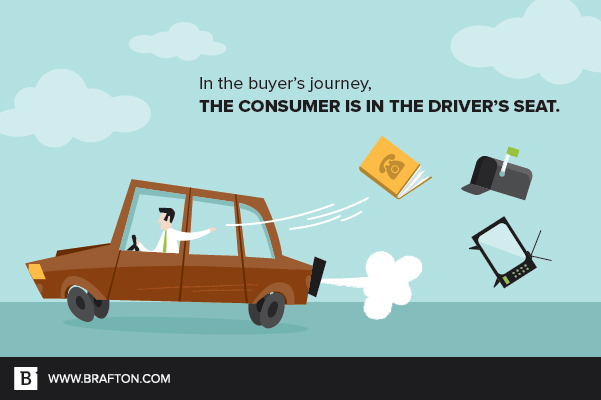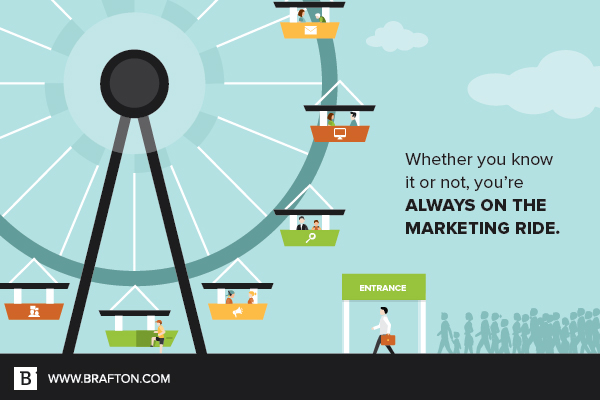What is marketing? At its heart, marketing is the connection of a product or service with a potential customer. Although fairly elemental as a concept, its various manifestations in the marketplace can sometimes feel as complex as astrophysics.
Nor is it getting any less complicated. Only a few years ago, finding the right product or service required a bit of work. Consumers turned to the Yellow Pages to seek out reputable businesses, or relied on word-of-mouth recommendations from family and friends, or even used the newly invented search engine, Google.

But things have drastically changed in a short amount of time. Today, consumers are equipped with more information – and power – than ever. The answers to their questions are at the tips of their fingers. A quick search brings up an endless number of possibilities to consider. People now have the ability to reach out to businesses to find the solutions they are searching for. The consumer, armed with deep reserves of self-serve information, is increasingly in the driver’s seat.
So what are marketers to do?
In his 2013 book, Jay Baer powerfully advocates the concept of “Youtility”: the practice of creating marketing-driven resources intended to help a potential customer answer questions, often during the research phase of the buyer journey. By being helpful and putting the customer’s needs first, the company allows trust and familiarity to grow between the prospective purchaser and the brand.
Everyone, however big or small, needs to content market or risk losing market share.
But how to create timely and relevant customer-facing resources is not a simple proposition. Content creation has become both a deep challenge and a sizeable opportunity for any business navigating the digital age. Everyone, however big or small, needs to content market or risk losing market share.
From outbound to inbound
Many factors have contributed to the evolution of marketing and the increasingly central role of content within the marketing mix.
Back in the days before search engines and social media, the onus was on businesses to reach out to potential customers, not the other way around. This meant that there were more traditional forms of marketing for companies to advertise through, such as television, radio, telephone and print publications – channels that were new and shiny in their day.
Today, it’s not just the channels that are changing, but the very structure of the marketing function.
“Marketing is too important to leave to the marketing department,” Hewlett Packard Enterprise founder David Hewlett presciently said.
And true to his word, modern-day marketers have been pushed to drastically switch up their approaches or lose ground in the marketplace. This has required a much greater emphasis on achieving a fully integrated marketing plan across all functions in the business, with content at its center.
It is the central job of company leadership to galvanize all of its people, regardless of function, around the effective marketing of its value proposition.
Gone are the days when marketing lived exclusively inside the walls of the marketing department. These days everybody is a marketer in some shape or form, whether they fully realize it or not. It is the central job of company leadership to galvanize all of its people, regardless of function, around the effective marketing of its value proposition.

The past is the future
While we live in a digital-first age, it is certainly not digital-only. In his 2015 article for Moz on “The Marketing Department of the Future,” Samuel Scott warned against imposing arbitrary lines between traditional and online marketing. The convergence of online and offline marketing can be immensely powerful, he argued.
“In large corporations and similar companies that have been in existence for decades, digital marketing is often added as a second parallel structure alongside the historical marketing activities. The incorrect assumption is that traditional and Internet marketing are entirely different things that need entirely separate approaches,” Scott wrote.
We needn’t choose between analog or digital, inbound or outbound. Done properly, it is both.
Simply put, there is no “perfect” marketing blueprint in today’s digital landscape. Just as there can’t be a “one size fits all” marketing strategy for every company, there can’t be a standard marketing organization either.
In our next blog post for the Leading Edge series, we will be looking at how different companies have addressed the challenges of adapting their business marketing to meet the demands and the opportunities of a fast-changing marketplace.
Want to dive deeper? Check out the rest of the Leading Edge series.
—
This article was co-authored by Richard Pattinson, CEO, and Tressa Sloane, Senior Manager of Editorial Development.




